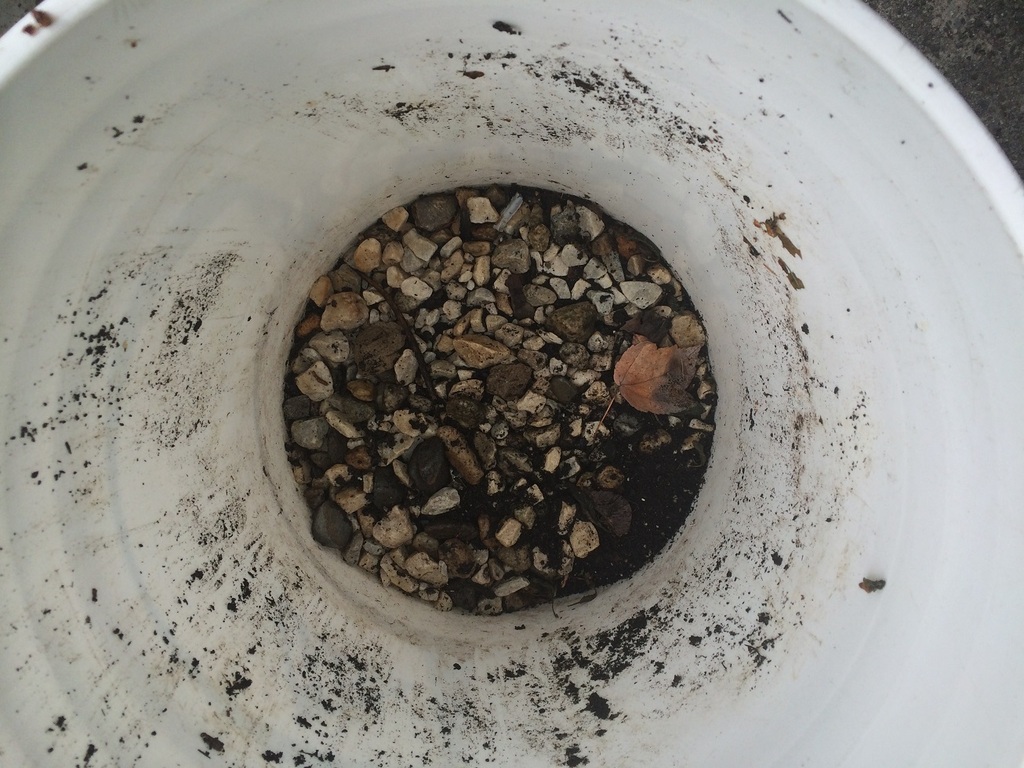-
Do you need help identifying a 🌶️?
Is your plant suffering from an unknown issue? 🤧
Then ask in Identification and Diagnosis. -
✅ Expert and friendly hot pepper grow advice.
✅ The latest information on hot pepper varieties.
✅ Reliable seed trading.
✅ Hot sauce recipes and food safety guidance.
✅ Hot sauce business tips for startups.
🌶️ And more!
It's all here, at The Hot Pepper! The Internet's original hot pepper community! Est. 2004.
You are using an out of date browser. It may not display this or other websites correctly.
You should upgrade or use an alternative browser.
You should upgrade or use an alternative browser.
plant-care Carolina Reaper plant - whats wrong? (Need help)
- Thread starter Frekk
- Start date
No, no tobacco user near or far from the plant. Will have a look at the copper fungicide suggestion!rickster said:might want to spray with a copper fungicide spray. are you a tobacco user? if so, always wash hands before touching plants.
Regards
Fredric
rickster seems to think it's a pathogen, either fungus or tobacco mosaic virus.
Probably because some of the leaves show either chlorosis of the veins or "vein clearing" which is common of many viruses, but can also be a symptom of over watering and related problems in the root zone. The scorched looking leaves are consistent with root rot.
I know you said that it was dry. Did you lift the pot to check if it was lighter, or is there a chance that you just assumed it was dry, but really the bottom of the pot was heavy and saturated? It happens surprisingly often. You can research the symptoms, get a second opinion, or if you think my diagnosis might make sense, then you can check the roots (brown color, slimy texture is root rot). Treatment is repotting and removing effected roots. Or you can flush with an enzyme product to digest the dead material.
You mentioned epsom salt. I don't think this is nutrient related. I could be wrong.
Probably because some of the leaves show either chlorosis of the veins or "vein clearing" which is common of many viruses, but can also be a symptom of over watering and related problems in the root zone. The scorched looking leaves are consistent with root rot.
I know you said that it was dry. Did you lift the pot to check if it was lighter, or is there a chance that you just assumed it was dry, but really the bottom of the pot was heavy and saturated? It happens surprisingly often. You can research the symptoms, get a second opinion, or if you think my diagnosis might make sense, then you can check the roots (brown color, slimy texture is root rot). Treatment is repotting and removing effected roots. Or you can flush with an enzyme product to digest the dead material.
You mentioned epsom salt. I don't think this is nutrient related. I could be wrong.
Id listen to Mr west, he seems to know his sh@#Mr. West said:rickster seems to think it's a pathogen, either fungus or tobacco mosaic virus.
Probably because some of the leaves show either chlorosis of the veins or "vein clearing" which is common of many viruses, but can also be a symptom of over watering and related problems in the root zone. The scorched looking leaves are consistent with root rot.
I know you said that it was dry. Did you lift the pot to check if it was lighter, or is there a chance that you just assumed it was dry, but really the bottom of the pot was heavy and saturated? It happens surprisingly often. You can research the symptoms, get a second opinion, or if you think my diagnosis might make sense, then you can check the roots (brown color, slimy texture is root rot). Treatment is repotting and removing effected roots. Or you can flush with an enzyme product to digest the dead material.
You mentioned epsom salt. I don't think this is nutrient related. I could be wrong.
I had to get a soil moisture detection device because I was so scared of overdoing it that I kinda starved mine. It has come in handy when I look at the soil and think oh its dry then the soil device tells me almost soggy and I wait another day or two and not kill my plants through Chinese water torture
Thanks I'm just trying to help. I haven't exactly seen this on my own plants. Making an educated guess based on the information I have. It mostly looks healthy.
Potassium deficiency can cause leaf scorch, but those leaves look like there's more than that going on. The symptoms don't clearly match a single definable nutrient or pH problem. But root issues can have a multiplicative effect of poor nutrient uptake and pH imbalance, resulting in the convoluted signs of leaf damage.
Potassium deficiency can cause leaf scorch, but those leaves look like there's more than that going on. The symptoms don't clearly match a single definable nutrient or pH problem. But root issues can have a multiplicative effect of poor nutrient uptake and pH imbalance, resulting in the convoluted signs of leaf damage.
Thanks for all the effort from you guys.
Right now I don't have that much more info. I removed the affected leves so it will be easier to see if the yellowing continues or if it was something temporary that no longer effects the plant.
I do lift the pots to feel if they need watering. I now lean towards a watering-issue. I think the plant was dry a bit too long, however, Mr.West, I haven't checked the roots yet. I'm at work right now and will try to have a look at it when I get back home, but the pot consists of a plastic pot with holes in the bottom. The bottom layer in the pot consists of hydrograins, so there is no water "standing" in the pot, but I do realize over-watering can still be an issue.
The reason that I now think that it's because too little water is that after I put the fan (Thanks Mr.west, the fans did solve both the edema and I've got two pods now) next to the plant, the plant transpire alot more water. The pot dries up very fast and I think I might have underestimated with which speed it dries up and therefore under-watered it. I base this on the fact that the pot was extremely light when I lifted it, but the leaves hadn't started to droop. I thank that's because it transpires so fast that the leaves gets damaged even before they start to droop.
I will have a look at it when I get home to see if there's any more yellowing and if the roots look ok. Mr.West, do you have any suggestion to check the roots, other than pulling up the plant?
Regards
Fredric
Right now I don't have that much more info. I removed the affected leves so it will be easier to see if the yellowing continues or if it was something temporary that no longer effects the plant.
I do lift the pots to feel if they need watering. I now lean towards a watering-issue. I think the plant was dry a bit too long, however, Mr.West, I haven't checked the roots yet. I'm at work right now and will try to have a look at it when I get back home, but the pot consists of a plastic pot with holes in the bottom. The bottom layer in the pot consists of hydrograins, so there is no water "standing" in the pot, but I do realize over-watering can still be an issue.
The reason that I now think that it's because too little water is that after I put the fan (Thanks Mr.west, the fans did solve both the edema and I've got two pods now) next to the plant, the plant transpire alot more water. The pot dries up very fast and I think I might have underestimated with which speed it dries up and therefore under-watered it. I base this on the fact that the pot was extremely light when I lifted it, but the leaves hadn't started to droop. I thank that's because it transpires so fast that the leaves gets damaged even before they start to droop.
I will have a look at it when I get home to see if there's any more yellowing and if the roots look ok. Mr.West, do you have any suggestion to check the roots, other than pulling up the plant?
Regards
Fredric
This little tool can be your friend.
Luster Leaf 2957 Rapitest Digital Soil Moisture Meter https://www.amazon.com/dp/B071K9L5WS/ref=cm_sw_r_cp_api_i_1tmmCbQDD8R57
Luster Leaf 2957 Rapitest Digital Soil Moisture Meter https://www.amazon.com/dp/B071K9L5WS/ref=cm_sw_r_cp_api_i_1tmmCbQDD8R57
As an Amazon Associate we earn from qualifying purchases.
If you're checking the pot's weight, then you can be confident that you're watering method is good. There's should be no need to check the roots.
Let's assume drought stress is the key factor. You do have about 4 leaves leaves there that are tan/necrotic beginning at the leaf margin. This is the typical presentation.
The leaves look like there's more afoot than dryness. Was there any discoloration before they dried out? Did you suspect Mg deficiency before, or what led you to feed epsom salt?
In high doses it can cause nutrient lockout of other cation elements by competing for uptake. (ruled this out before, because only your old leaves appear affected). Drying can also increase salt formation, which would need to be flushed out at the next feed/watering (thoroughly drench the media to the point of runoff).
Just throwing ideas out there.
Let's assume drought stress is the key factor. You do have about 4 leaves leaves there that are tan/necrotic beginning at the leaf margin. This is the typical presentation.
The leaves look like there's more afoot than dryness. Was there any discoloration before they dried out? Did you suspect Mg deficiency before, or what led you to feed epsom salt?
In high doses it can cause nutrient lockout of other cation elements by competing for uptake. (ruled this out before, because only your old leaves appear affected). Drying can also increase salt formation, which would need to be flushed out at the next feed/watering (thoroughly drench the media to the point of runoff).
Just throwing ideas out there.
Mr.West, given your description, Im starting to suspect it could be nutrition-blocking. The reason I used epsom salt was, not because a deficiency, but because the plant kept dropping flowers and didnt set fruit. I read that epsom salt would increase the plants ability to absorb nutrients and I thought this might help it to set fruit.
And, after the first use, it did set fruit. However, the use of epsom salt and the plant setting fruit could of course be a coincidence... But as I saw it, the epsom salt helped and therefore I added more when I watered 4 days ago. It could, as you say Mr.West, have resulted in blocking of nutrients.
What I use as nutrient is a liquid fertilizer with 4-3-5 and have added a layer of bat guano on top of the soil. The bat guano is around 2-12-2. The liquid fertilizer has been used during the plants entire life, the bat guano was added about the time this thread here at THP was started.
I noticed that the edges of a few new leaves are a bit curled.
Does this information help anything? Could it be the epsom salt thats the culprit here? Do I re-pot it if thats the case?
Regards
Fredric
And, after the first use, it did set fruit. However, the use of epsom salt and the plant setting fruit could of course be a coincidence... But as I saw it, the epsom salt helped and therefore I added more when I watered 4 days ago. It could, as you say Mr.West, have resulted in blocking of nutrients.
What I use as nutrient is a liquid fertilizer with 4-3-5 and have added a layer of bat guano on top of the soil. The bat guano is around 2-12-2. The liquid fertilizer has been used during the plants entire life, the bat guano was added about the time this thread here at THP was started.
I noticed that the edges of a few new leaves are a bit curled.
Does this information help anything? Could it be the epsom salt thats the culprit here? Do I re-pot it if thats the case?
Regards
Fredric
Epsom salt is water soluble. Like I said it would be good if you flush out the salts with plain water or liquid feed. Slowly water until there is runoff from the bottom. Try to continue what you've been doing up until now. The plant looks good, nice pod btw.
Im with the school of thought that only uses epsom salt as a remedy, usually foliar application to supplement Mg deficiency. At too high a concentration it can compete with Ca, potentially causing new growth to be distorted or curled.
Im with the school of thought that only uses epsom salt as a remedy, usually foliar application to supplement Mg deficiency. At too high a concentration it can compete with Ca, potentially causing new growth to be distorted or curled.
Frekk said:Mr.West, I will try to flush it. Thinking of putting it in the shower and shower it gently for a period of time, and then let it dry back up. Is this a good way to go you think, or could it be too much water?
Too much water isn't an issue. You want it thoroughly drenched. It doesn't really need a ton of water, just enough to saturate it until it starts draining. If you do flush with plain water in the shower, then afterward you will probably want to give it a regular dose of liquid feed to provide some soluble nutrients. They will bond with the roots, releasing the magnesium sulfate. I think this is the best course. It's usually less stress on the plant than if you were to just flush plain and remove all available nutes.
Also, I saw you mentioned using hydrograins in the bottom of the pot. I've read posts about using a layer of coarse material like rocks or hydroton to help drainage. Here's an article offering an opposing viewpoint.
Very interesting article Mr.West! As it happens, I bought a new bag with perlite last week when I ordered nexr seasons seeds. Ive had some thoughts of re-potting the affected plant into a large glass jar (its a rectangular, standing jar that my grand-grand father used to store acid in hos shop). I just need to bore a drainage-hole in the bottom of it. I think it would be nice to get a use for the jar and at the same time be able to see how the roots evolve. I just have one doubt about this - would the light shining through impact the roots in a negative way?
Otherwise, a re-potting after the flush might be the way to go...
Regards
Fredric
Otherwise, a re-potting after the flush might be the way to go...
Regards
Fredric
`Frekk said:Very interesting article Mr.West! As it happens,
Regards
Fredric

I always put small stones in my pots for drainage, see below, but also to insure the holes in the pot did not become plugged and my watering regimen makes this a necessity.

`

I don't see any problem with the glass jar. You might want to cover it with something removable to block light. It would be interesting to see the root structure and moisture level, etc. NECM has a valid point, the rocks prevent finer media from plugging the drainage holes. I think the key to this is a "drain to waste" style of watering. Much like a flush, where you water to the point of runoff, but done consistently every time. That article mentions the necessity of doing so, because water will not drain through the rocks until the upper level is fully saturated.
The benefit of dtw is that the water leaving the bottom of the pot creates a vacuum of fresh air being drawn in at the surface level. This replenishes the oxygen available to the roots, keeping the soil aerobic and preventing a stagnant anaerobic rhizosphere. Also, dtw is like performing regular maintenance by ridding the soil of unused nutrients that could otherwise form mineral salt compounds leading to nutrient lockout.
The benefit of dtw is that the water leaving the bottom of the pot creates a vacuum of fresh air being drawn in at the surface level. This replenishes the oxygen available to the roots, keeping the soil aerobic and preventing a stagnant anaerobic rhizosphere. Also, dtw is like performing regular maintenance by ridding the soil of unused nutrients that could otherwise form mineral salt compounds leading to nutrient lockout.
Frekk said:Mr.West - Ill use your and NECMs input and hopefully re-pot tomorrow, given I manage to bore one or several holes in the glass jar and keeping it intact... I did flush the plant todayI will post an update tomorrow - either with a reaper in a jar or a pile of glass...
//Fredric
Sounds like a cool heirloom. Good luck with the drilling and repotting. A glass-cutting diamond bit submerged in water should do it.
You are brave, I wouldnt drill glass for nothing. Best of luckFrekk said:Mr.West - Ill use your and NECMs input and hopefully re-pot tomorrow, given I manage to bore one or several holes in the glass jar and keeping it intact... I did flush the plant todayI will post an update tomorrow - either with a reaper in a jar or a pile of glass...
//Fredric
